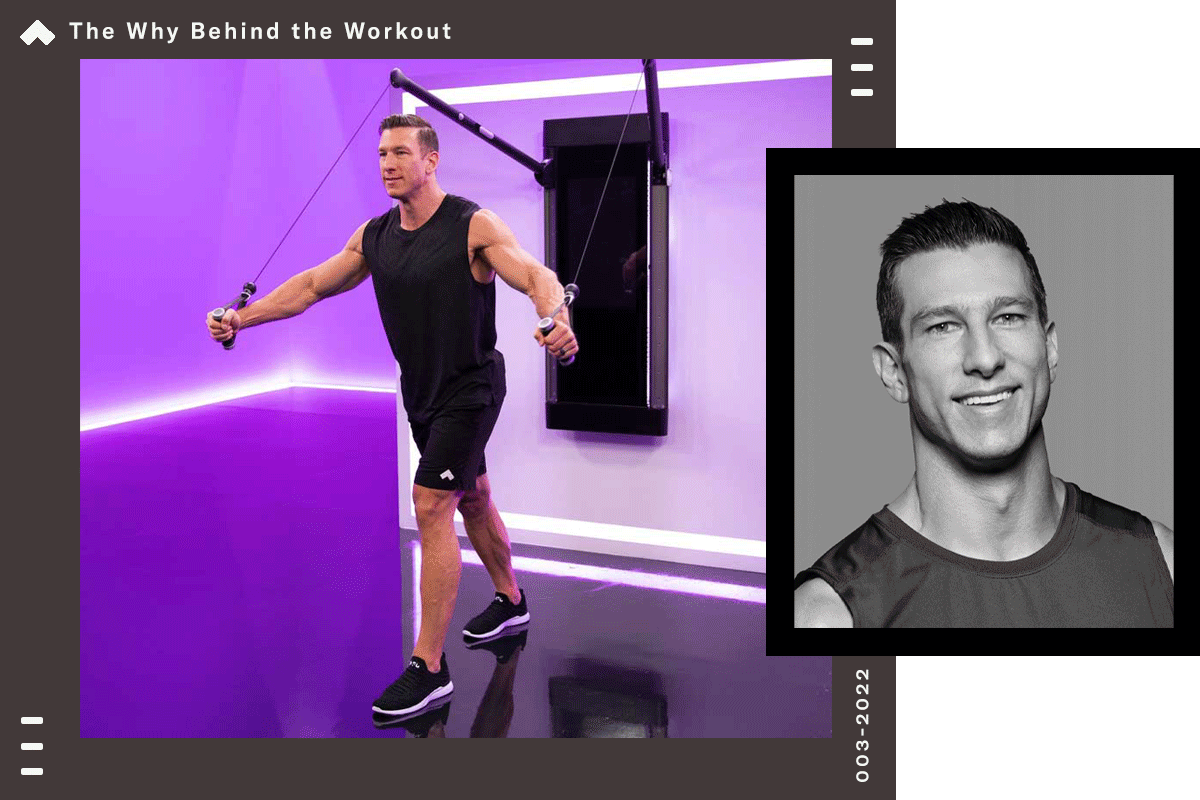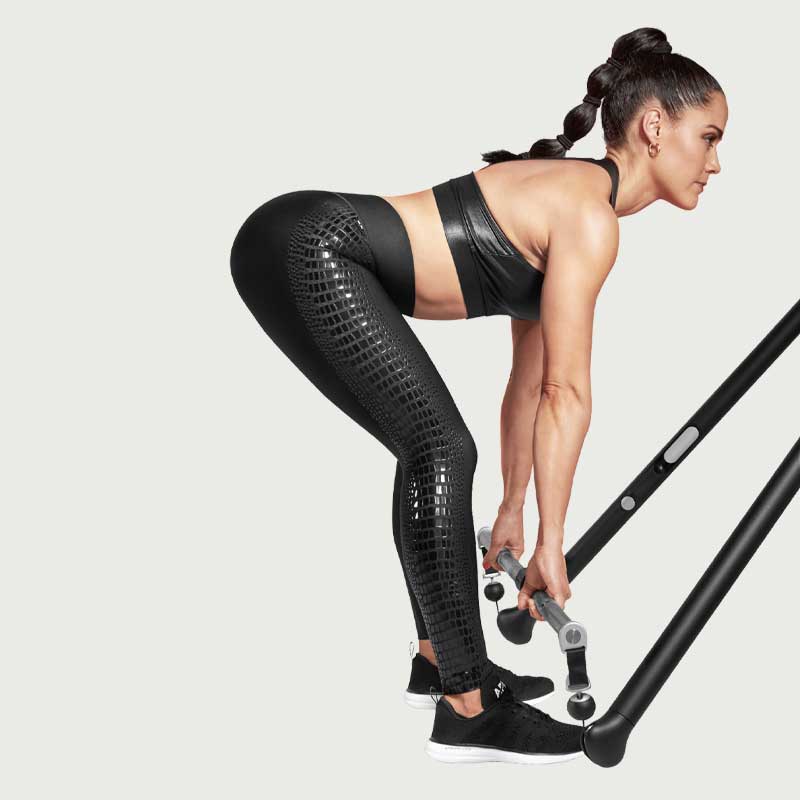This program, inspired by classic bodybuilding training, will supercharge hypertrophy and help you bust through any plateau.

Every time you do a coach-led workout on Tonal, you’re completing a specific series of exercises in a particular order designed to maximize your results. In this series, The Why Behind the Workout, we break down the science behind a particular workout or program.
Here, we go deep on Go Big or Go Home 3 with Tonal coach and certified personal trainer Jackson Bloore.
Who It’s For
Like the first two programs in the wildly popular Go Big or Go Home series, the third edition is designed for experienced lifters seeking accelerated muscle growth. With a combination of high-volume sets and low-rep, heavy-weight sets, this program is best suited for advanced members. The workouts won’t be easy, but you’ll end the program feeling strong, shredded, and more confident than when you started.
“When you finish one of these workouts, you will feel an immense amount of pride,” says Bloore. “This program is going to push you to your limits and beyond, but that’s exactly why you’re going to see physical changes in your body. There’s no growth inside your comfort zone.”
Go Big or Go Home 3 is a step up in intensity from its predecessors, but you don’t need to have completed those to give it a try. As long as you’re familiar with advanced-level movements such as the barbell front squat and barbell overhead press, you should be up to the challenge. With its focus on the arms, chest, and back, Go Big or Go Home 3 will help anyone who wants to develop more upper-body strength.
It’s also great for women looking to try a new type of training. Josh Clay, a certified strength and conditioning specialist and Fitness Programming Specialist at Tonal, says it’s especially beneficial for women who have hit a plateau after following high-intensity programs exclusively. “If you’ve noticed your results have stalled out, this is a good program to switch up the stimuli and get the engine turning again,” he says.
The Goal
As its name suggests, this program is all about hypertrophy, or building bigger muscles, and getting stronger. “You can also do it to improve your body composition by increasing muscle and losing fat,” says Clay.
Your nutrition will play a role in this, too. If you’re eating in a calorie deficit (taking in fewer calories than you burn each day) during the program, you’re likely to lose fat while maintaining muscle mass. To gain muscle mass, consider a calorie surplus in which you’re eating more calories than you burn.
How it Works
In this program, Bloore utilizes three different repetition schemes inspired by bodybuilding to ensure maximum muscle growth.
The first block of each workout uses modified wave loading, alternating between high and low repetition sets for each exercise. For example, you’ll do 5 reps of an exercise in the first and third sets of this block and 10 reps at a lighter weight in the second and fourth sets.
“Those heavier sets activate the higher threshold motor units that we’re trying to grow,” says Clay. “When you get to that set of 10 reps, hopefully, it feels lighter, and you can improve your output.” Bloore adds that modified wave sets also trigger “nervous system activation and a better metabolic response in the body.”
The exercises in the second block of each workout are structured in an ascending rep scheme, with reps increasing and resistance decreasing as the sets progress. “You’re getting those heavy sets out of the way first when you’re most focused and energetic,” says Bloore. Completing subsequent sets with higher reps and lighter weight creates more metabolic stress, fueling muscle growth.
In the third and final block of each workout, expect straight sets with the number of repetitions for each exercise staying the same. The volume kicks into high gear during this block with sets of up to 20 repetitions per move. Since your muscles will be burning by this point, Bloore employs Tonal’s Burnout Mode during some exercises in this block. This dynamic weight mode senses when you’re struggling and reduces the weight so you can finish out the set with good form.
The Key Moves
It wouldn’t be a Go Big or Go Home program without some classic, heavy lifts. Here’s a taste of what to expect in these workouts.
Barbell Bench Press

To strengthen muscles from every angle, Go Big or Go Home 3 uses a push-pull format. Upper-body pushing exercises involve pushing weight away from your body and target the chest, shoulders, and triceps. Pulling exercises work in the opposite direction, challenging the back, biceps, and forearms. The barbell bench press is an essential push exercise for building chest muscles.
Barbell Bent Over Row

This upper-body pull move engages the back muscles and balances out the work you’ll do on the front of your body in push exercises. It’s a classic bodybuilding exercise that’ll work your lats, traps, and deltoids.
Barbell Front Squat

There are push and pull exercises for the lower body, as well, and the squat is a foundational lower-body push move that primarily targets the quads and glutes.
Barbell RDL

A lower-body pull to complement the squat, this deadlift variation targets the glutes and hamstrings while activating the hip hinge movement pattern.
When to Do it
Go Big or Go Home 3 consists of 16 workouts designed to be completed four times per week for four weeks. Clay recommends doing the first two workouts of the week on consecutive days, followed by a rest day; and then the third and fourth workouts on consecutive days followed by two rest days. For example, you could do the program workouts on Monday, Tuesday, Thursday, and Friday.
“We want to train in a way that allows us to recover from the stress that we’re applying to our muscles,” says Clay. “If you’re training in a fatigue state, that’s going to affect your output, and that’s also going to decrease the results you see from the program.”
Although the first two workouts of each week both target the upper body, the first workout features pushing exercises, such as the standing overhead press and chest fly, while the second includes pulling moves such as biceps curls and lat pulldowns. Because the push and pull movements are performed on separate days, these workouts can be done consecutively without fatiguing the same muscles.
The third workout of the week is leg day, featuring challenging lower-body exercises including barbell Romanian deadlifts and racked reverse lunges. Bloore promises this workout will deliver the type of “legendary, hardcore leg day” that the previous Go Big or Go Home programs are known for.
Finally, you’ll round out the week with a push-pull workout that challenges all the muscles of the upper body. “You’re going to feel a fantastic pump,” says Bloore. “You’re going to feel so big and strong that you have to walk through a doorway sideways.” You’ll definitely appreciate two days of rest after that one.
Perfect Pairings
Go Big or Go Home Cardio – Coach Jackson Bloore

If you want to get your heart rate up between lifting sessions, Bloore designed this off-Tonal cardio workout specifically to complement the Go Big or Go Home programs. While it’ll definitely get you sweaty, be careful not to push too hard on your off days.
“You should leave the workout feeling like you could do more,” says Clay. “If you’re leaving the workout exhausted and huffing and puffing, then you’re probably negatively impacting your output in the Go Big or Go Home workouts.”
Advanced Full Body Mobility – Coach Liz Letchford

Another strategy for off days is focusing on recovery and restoring blood flow to the muscles. In this recovery workout, you’ll activate the hips and shoulders, which will lead to better performance in lifts such as your squat and overhead press.
What to Do Next
Power Build – Coach Joe Rodonis

Once you’ve crushed these 16 challenging workouts, you’ll be ready to take on any program Tonal has to offer. In Power Build, you’ll continue building muscle but the emphasis shifts to lower volume and higher weight sets geared toward generating both strength and power. Switching up the stimulus prevents your muscles from becoming overstressed with one training style. “Higher volume workouts like Go Big or Go Home place a lot of stress on our muscles,” says Clay. “We want to make sure that we’re also keeping longevity at the forefront of our mind.”


